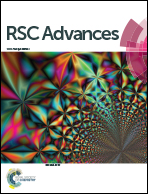Copper–silver oxide nanowires grown on an alloy electrode as an efficient electrocatalyst for water oxidation
Abstract
Copper–silver oxide nanowires (CuO–Ag2O NWs) are obtained by a simple preparation method of immersing a CuAgZn alloy in a Na2O2 aqueous solution and annealing at 300 °C in air. The nanowires are used as an electrocatalyst for the oxygen evolution reaction (OER) in an alkaline aqueous solution. Through contrasting with several compositions of the alloy, we observe the best electrochemical performance from a specific metal oxide grown on CuAgZn with a mass ratio of 47% : 28% : 25%, which displays an overpotential of 0.448 ± 0.02 V at 20 mA cm−2 and 0.475 ± 0.01 V at 30 mA cm−2, as well as a Tafel slope of 118 ± 4 mV dec−1. Copper–silver oxide nanoparticles, copper oxide nanoparticles, and silver oxide nanoparticles (CuO–Ag2O NPs, CuO NPs and Ag2O NPs) are also prepared to compare with CuO–Ag2O NWs. The results indicate the as-prepared CuO–Ag2O NWs show an improved activity for the OER. Furthermore, the prepared CuO–Ag2O NWs show good stability, where the normalized current density can remain at over 80% after the electrolysis of 10 000 s. This strategy for the fabrication of CuO–Ag2O NWs is a promising and facile way to develop more multi-metal oxide catalysts for energy conversion.


 Please wait while we load your content...
Please wait while we load your content...